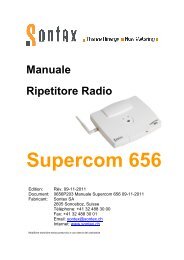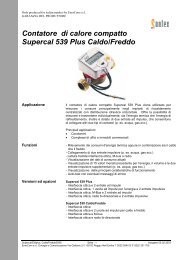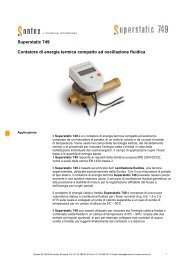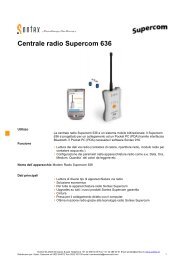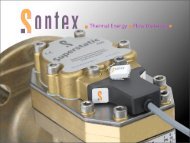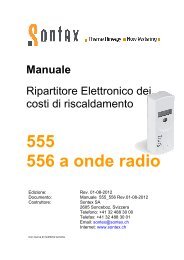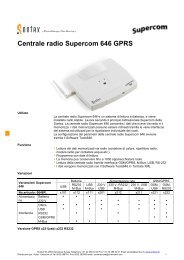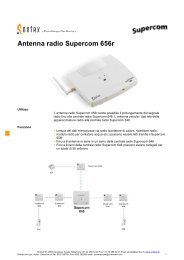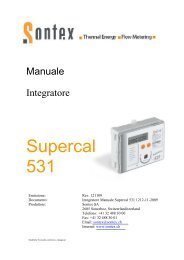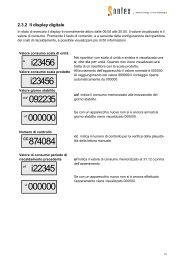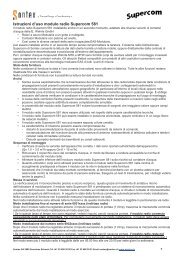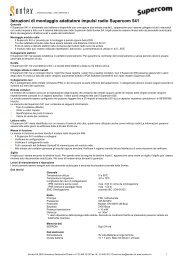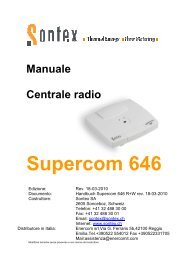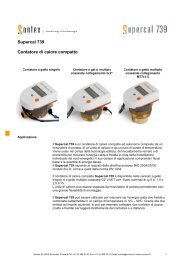Installation Radio Signal Meter 846 EN DE FR IT 17-07-2011
Installation Radio Signal Meter 846 EN DE FR IT 17-07-2011
Installation Radio Signal Meter 846 EN DE FR IT 17-07-2011
Create successful ePaper yourself
Turn your PDF publications into a flip-book with our unique Google optimized e-Paper software.
Auswechseln der Batterie:<br />
- Funkwellensender<br />
Wenn die Anzeige „Batterie schwach“ erscheint, wird empfohlen, die<br />
Batterie auszuwechseln. Zu diesem Zweck die bewegliche<br />
Abdeckung öffnen, die Schraube, die den Deckel des Gerätes<br />
festhält, lösen und diesen durch Drücken nach oben und hinten<br />
wegnehmen. Die Bride, welche die Batterie festhält, öffnen (die Bride<br />
ist wiederverwendbar) und den Stecker des Kabels, das die Batterie<br />
mit der Elektronikkarte verbindet, lösen. Dazu muss der Clip des<br />
Steckers leicht gedrückt werden, um ihn vom Buchsenteil zu lösen.<br />
Nach dem Auswechseln der Batterie muss durch Drücken der Taste<br />
an der Haupt-Elektronikkarte während ca. ½ Sekunde ein «Reset»<br />
des Gerätes durchgeführt werden.<br />
Wichtig: Wenn in anderen Situationen ein «Reset» erfolgt oder<br />
erzeugt wird, funktioniert die Anzeige „Batterie schwach“ nicht mehr<br />
richtig.<br />
- Funkempfänger<br />
Wenn an der Anzeige die Meldung „Lo bAt“ erscheint, die Taste<br />
drücken, um das Gerät weiterhin zu verwenden.<br />
Im Feldstärke-Modus (RSSI) steht nach der Anzeige für „Batterie<br />
schwach“ eine theoretische Betriebsreserve von 24 Stunden zur<br />
Verfügung, im Adressenanzeige-Modus jedoch keine.<br />
Die Batterie des Funkempfängers kann nicht ausgewechselt<br />
werden, sondern nur der ganze Funkempfänger. Das Gehäuse<br />
des Funkempfängers darf weder geöffnet noch beschädigt werden.<br />
Andernfalls erlischt jegliche Garantieleistung.<br />
Empfehlungen<br />
Die Datenübertragung über Funk hängt von den funktechnischen<br />
Ausbreitungsbedingungen am Standort ab. Mobile Funkverbindungen<br />
können unter bestimmten atmosphärischen oder örtlichen<br />
Bedingungen (insbesondere im Innern von geschlossenen Räumen)<br />
nicht jederzeit und überall hergestellt werden. Der Anwender muss<br />
die Funkausbreitungsbedingungen am vorgesehenen Standort<br />
überprüfen. Je nach den physikalischen Bedingungen können die<br />
Sende- und Empfangsreichweiten im Innern von Gebäuden<br />
variieren. In der Nähe der Funkzentrale Supercom 646, des<br />
Funkverstärkers Supercom 656 R und der funkfähigen Geräte<br />
müssen Wärmestrahlungen, elektromagnetische Felder und<br />
Funkstörungen vermieden werden.<br />
Folgende Faktoren können die Empfangsbedingungen beeinflussen:<br />
- Oberwellenstörungen von Funksteuerungen.<br />
- Übermodulation des Empfängers durch mobile Funkantennen und<br />
Mobiltelefone in unmittelbarer Umgebung.<br />
- Sporadische Störungen durch Sender auf benachbarten Kanälen.<br />
Sicherheitshinweise<br />
Die Funkwellenmesseinrichtung <strong>846</strong> hat das Werk in einwandfreiem<br />
Betriebs- und Sicherheitszustand verlassen. Um diesen Zustand<br />
aufrechtzuerhalten und im Einsatz der Messeinrichtung (Sender und<br />
Empfänger) muss der Anwender den im Handbuch Supercom 646<br />
GPRS enthaltenen Sicherheitshinweis beachten.<br />
Betrieb und Wartung: Hinweis für die Entsorgung<br />
Die Lithiumbatterie ist nicht wiederaufladbar. Die Batterie des<br />
Funkwellensenders muss umweltgerecht entsorgt oder dem<br />
Hersteller zur Entsorgung zurückgegeben werden. Auf diese Weise<br />
können wir die Komponenten in Übereinstimmung mit den<br />
Vorschriften für Batterien und elektronische Abfälle entsorgen. Wenn<br />
Sie die Entsorgung selber ausführen, erkundigen Sie sich über die<br />
Rezyklierungsmöglichkeiten in Ihrer Region<br />
Technische Unterstützung<br />
Wenden Sie sich für technische Unterstützung an die örtliche<br />
Sontex-Vertretung oder direkt an Sontex.<br />
Procédure de changement de la batterie:<br />
-L’émetteur d’ondes radio<br />
Lorsque l’indication de batterie faible apparait, il est recommandé de<br />
changer la pile. Pour cela, ouvrez le capot mobile, dévissez la vis qui<br />
fixe le couvercle de l’appareil et déboîtez-le en le poussant vers le<br />
haut et vers l’arrière. Ouvrez la bride qui maintient la pile (la bride est<br />
réutilisable) et débranchez le connecteur du câble qui relie la pile à la<br />
carte électronique. Il faut pousser légèrement le clip du connecteur<br />
mâle vers l’arrière pour débloquer la partie femelle du connecteur<br />
reliée au câble. Après le changement de la batterie, il faut encore<br />
faire un « Reset » de l’appareil en pressant environ ½ seconde le<br />
bouton situé sur la carte électronique principale.<br />
Attention: Si un « Reset » se produit ou est généré dans d’autres<br />
situations, la détection de fin de vie de la pile sera erronée.<br />
-Récepteur radio<br />
Lorsque le message “ Lo bAt “ apparaît sur l’affichage, pressez le<br />
bouton pour continuer d’utiliser normalement l’appareil.<br />
Il existe une réserve de fonctionnement théorique de 24h en mode<br />
Intensité de Champ (RSSI) après la détection de la fin de vie de la<br />
pile, mais aucune autonomie en mode Visualisation d’Adresse.<br />
Il n’est pas possible de changer la pile du récepteur radio. Il faut<br />
remplacer le récepteur radio.Le boîtier du récepteur radio ne doit<br />
pas être ouvert ni être endommagé. Dans le cas contraire, toute<br />
prestation de garantie sera invalidée.<br />
Recommandations<br />
La transmission de données par radio est tributaire des conditions de<br />
propagation radiotechnique sur le lieu de montage. Les liaisons<br />
mobiles par radio ne peuvent pas être établies à tout moment et en<br />
tout lieu dans certaines circonstances atmosphériques ou<br />
géographiques (en particulier à l'intérieur des locaux fermés).<br />
L’utilisateur doit vérifier les conditions de propagation radio sur le lieu<br />
d'installation prévu. Sur la base des conditions physiques, les<br />
portées d'émission et de réception à l'intérieur des bâtiments sont<br />
susceptibles de varier. Le rayonnement thermique, les champs<br />
électromagnétiques et les parasites doivent être évités à proximité de<br />
la centrale radio Supercom 646, du répéteur radio Supercom 656 R<br />
et des appareils radio.<br />
Les propriétés de réception peuvent être influencées par:<br />
- Les parasites d'harmoniques de commandes radio<br />
- La sur-modulation du récepteur par des antennes radio mobiles et<br />
les téléphones mobiles au voisinage immédiat<br />
- Des perturbations par des émetteurs sur des canaux adjacents<br />
Consignes de sécurité<br />
Le testeur de champs radio <strong>846</strong> a quitté l’usine en parfait état de<br />
marche et de sécurité. Pour conserver cet état et pour exploiter le<br />
testeur (émetteur et récepteur), l'utilisateur doit observer les<br />
consignes de sécurité figurant dans le manuel Supercom 646 GPRS.<br />
Exploitation et entretien: Conseil d'élimination<br />
La pile au lithium n'est pas rechargeable. La batterie de l’émetteur<br />
d’ondes radio doit être éliminée de façon à protéger l'environnement<br />
ou doivent être retournés au fabricant pour leur élimination. Ainsi<br />
nous pouvons disposer des composants selon les prescriptions<br />
relatives aux batteries et aux déchets électroniques. Si l'élimination<br />
est réalisée par vous-même, informez-vous aux possibilités de<br />
recyclage dans votre région.<br />
Assistance technique<br />
Pour l'assistance technique, s'adresser au représentant Sontex local,<br />
ou directement à Sontex<br />
Procedure to change the battery of the transmitter <strong>846</strong>:<br />
-Remote radio transmitter<br />
When the low battery indication appears, it is recommended to<br />
change the battery. To do this, open the moving cover, unscrew the<br />
screw which sets the lid of the device and push it upward and<br />
backward. Open the strap that holds the battery (the strap is<br />
reusable) and disengage the connector of the cable that connects<br />
the battery to the electronic board. Push slightly the clip of the male<br />
connector back to unlock the female part connected to the cable.<br />
After the change of the battery, a "Reset" should be made by<br />
pressing approximately ½ second the button located on the main<br />
electronic board.<br />
Caution: If a "reset" occurs or is generated in other situations, the<br />
detection of the end of life of the battery will be wrong.<br />
Remote radio receiver<br />
When the message "Lo bAt " appears on the display, press the<br />
button to continue the normal operation of the device.<br />
There is an theoretical operating reserve of 24 hours after detecting<br />
the end of battery life in RSSI Mode, but no operating reserve in<br />
View Address Mode. It is not possible to change the battery. The<br />
remote radio receiver must be replaced. The housing of the radio<br />
receiver should not be opened or damaged, otherwise any warranty<br />
will be invalid.<br />
Recommendations<br />
Sontex explicitly draw attention to the fact that the data transmission<br />
depends of the radio propagation conditions in the installation<br />
location. Because of atmospheric or geographical circumstances<br />
(particularly within enclosed spaces), mobile radio transmissions<br />
cannot be made at anytime and anywhere. It is the responsibility of<br />
the user to verify the conditions of propagation at the planned place<br />
of installation.<br />
Based on the physical conditions, the transmission and reception<br />
ranges inside buildings may vary or be null.<br />
Heat radiations and electromagnetic fields should be avoided near to<br />
the radio central Supercom 646, the repeater Supercom 656R and<br />
the radio devices.<br />
The receiving properties can be influenced by:<br />
- Parasites of harmonic of radio remote controllers<br />
- The over modulation of the receiver due to mobile radio antennas<br />
or mobile phones in the immediate vicinity<br />
- Sporadic disturbances due to transmitters on adjacent channels.<br />
Safety information<br />
The radio tester <strong>846</strong> left the factory in a perfect working order and<br />
safety. To maintain this condition and to operate the tester<br />
(transmitter and receiver), the user must follow the safety instructions<br />
specified in the user guide Supercom 646 GPRS.<br />
Operation and Maintenance : Board of elimination<br />
The lithium battery is not rechargeable. The batteries of the radio<br />
signal meter should be eliminated to protect the environment or be<br />
returned to the manufacturer for disposal.<br />
If the removal is carried out by yourself, please inform you about the<br />
recycling options in your area.<br />
Technical Support<br />
For technical support contact your local Sontex agent or Sontex<br />
directly.<br />
Procedura per cambiare la batteria<br />
-Trasmettitore radio<br />
Quando l'indicatore ‘’batteria scarica’’ appare, si consiglia di<br />
sostituire la batteria.<br />
Per farlo, aprire la cappa mobile, svitare le viti che fissano il<br />
dispositivo e dislocare spingendo verso l'alto e all'indietro. Aprire la<br />
fascetta che tiene la batteria (la fascetta è riutilizzabile) e scollegare il<br />
cavo che collega la batteria alla scheda elettronica. Spingere il clip<br />
leggermente per liberare la parte femmina del connettore collegato al<br />
cavo.Dopo la sostituzione della batteria, si deve ancora fare un<br />
"reset" del dispositivo premendo per circa ½ secondo il pulsante sulla<br />
scheda principale.<br />
Attenzione: se un "reset"si verifica o viene generato in altre<br />
situazioni, la rilevazione di fine vita della batteria sarà sbagliato.<br />
-Ricevitore radio<br />
Quando il messaggio "Lo bAt " appare sulla visualizzazione,<br />
premere il pulsante per continuare il normale funzionamento del<br />
dispositivo. C’ è una riserva di funzionamento teorica di 24 ore in<br />
modo RSSI dopo la rilevazione della fine vita della batteria, ma non<br />
esiste nessuna riserva in modo visualizzazione di indirizzo.<br />
La batteria del ricevitore non puo essere cambiata. Il ricevitore<br />
radio deve essere sostituto.<br />
Il ricevitore radio non deve essere aperto o danneggiato. In caso<br />
contrario, ogni garanzia decade.<br />
Raccomandazioni<br />
Sontex espressamente richiama l'attenzione sul fatto che la<br />
trasmissione dei dati dipende della propagazione delle onde radio<br />
nel luogo di montaggio, e che i collegamenti mobili non possono<br />
essere stabiliti in qualsiasi momento e in qualsiasi luogo per via delle<br />
condizioni atmosferiche o geografiche (in particolare all'interno di<br />
spazi chiusi). È la responsabilità dell'utente di verificare le condizioni<br />
di propagazione radio sul luogo di installazione previsto.<br />
In base alle condizioni fisiche, la portata di trasmissione e ricezione<br />
all'interno di edifici possono variare o essere nulla.<br />
Radiazione di calore, campi elettromagnetici e parassiti dovrebbero<br />
essere evitati nei pressi della centrale radio Supercom 646, il<br />
ripetitore radio Supercom 656R e i dispostivi radio.<br />
Le proprietà di ricezione può essere influenzata da:<br />
- I parassiti dell’ armonica radio di radiocontrolli<br />
- La sopra modulazione del ricevitore da antenne di telefonia mobile<br />
e cellulari nelle immediate vicinanze<br />
- trasmissione di interferenze sporadici su dei canali adiacenti.<br />
Informazioni sulla sicurezza<br />
Il tester di campo radio<strong>846</strong> ha lasciato la fabbrica in perfetto stato di<br />
funzionamento e di sicurezza. Per mantenere questa condizione e<br />
far funzionare il tester (trasmettitore e ricevitore), l'utente deve<br />
seguire le istruzioni di sicurezza del manuale Supercom 646 GPRS.<br />
Esercizio e Manutenzione: Consiglio di eliminazione<br />
La batteria al litio non è ricaricabile. La batteria del tester de campo<br />
radio deve essere eliminata per proteggere l'ambiente o essere<br />
restituita al produttore per lo smaltimento. Se la rimozione è<br />
effettuata da voi stessi, informatevi sulle possibilità di riciclaggio nella<br />
sua zona.<br />
Assistenza tecnica<br />
Per l’assistenza tecnica, contattare l’agente Sontex della zona o<br />
Sontex direttamente.<br />
Konformität nach R&TTE 1999/5/CE<br />
Die detaillierten Konformitätserklärungen finden Sie auf unserer<br />
Homepage: www.sontex.ch<br />
Änderungen vorbehalten<br />
Conformité selon R&TTE 1999/5/CE<br />
Les déclarations de conformité détaillées peuvent être trouvées sur<br />
note site: www.sontex.ch<br />
Sous réserve de modifications<br />
Conformity selon R&TTE 1999/5/CE<br />
Detailed declaration of conformity can be found on our website:<br />
www.sontex.ch<br />
Technical modifications subject to change without notice<br />
Conformità secondo R&TTE 1999/5/CE<br />
Le dicchiarazioni di conformità in dettaglio si trovano sul nostro sito:<br />
www.sontex.ch<br />
Sotto riserva di modificazioni senza preaviso<br />
Hotline Sontex: sontex@sontex.ch, +41 32 488 30 04<br />
<strong>Installation</strong> <strong>Radio</strong> <strong>Signal</strong> <strong>Meter</strong> <strong>846</strong> <strong>EN</strong> <strong>DE</strong> <strong>FR</strong> <strong>IT</strong> 09-06-<strong>2011</strong><br />
© Sontex SA 2010<br />
0<strong>846</strong>P100<br />
Sontex SA 2605 Sonceboz Suisse Tel +41 32 488 30 00 Fax +41 32 488 30 01 Email sontex@sontex.ch www.sontex.ch 4



